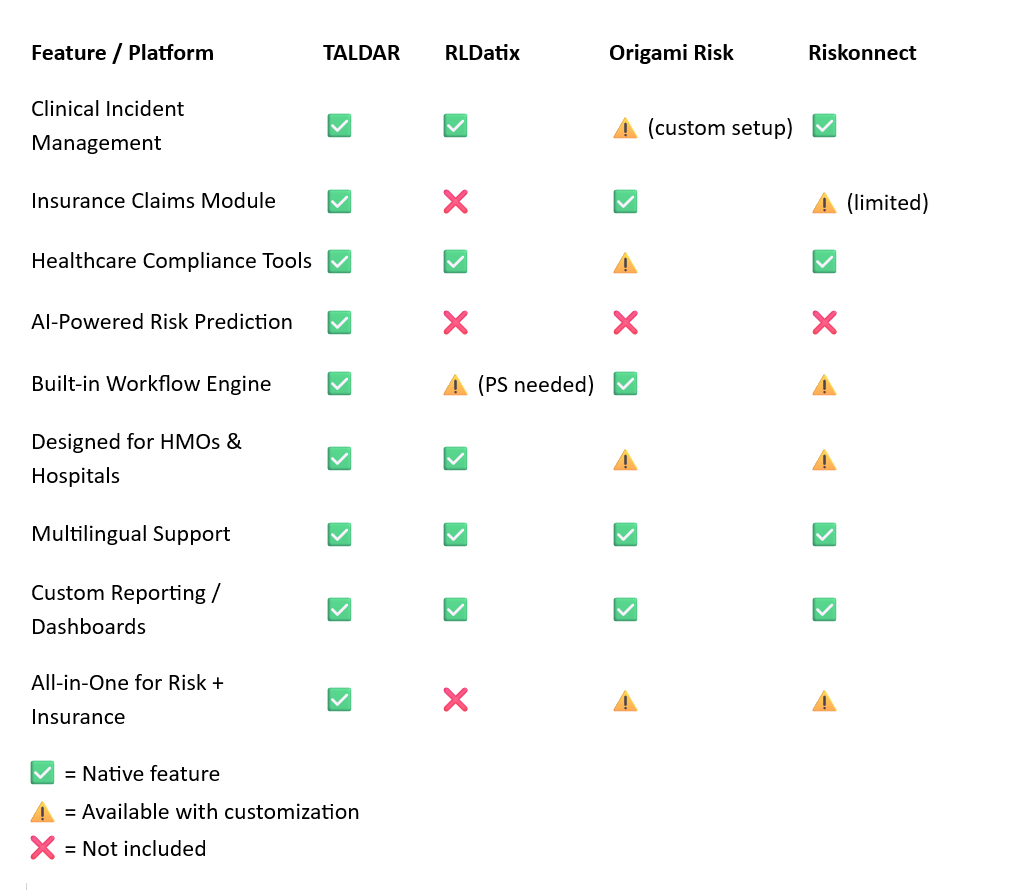In 2025, the demand for effective risk management software in healthcare is more urgent than ever. Hospitals, HMOs, and healthcare networks face rising threats—from patient safety incidents and claims, to regulatory compliance and operational vulnerabilities. The right software isn't just a tool; it's a shield, a compliance partner, and often a lifesaver.
Below, we explore the four top contenders in the risk management software market—with a spotlight on Taldar, an Israeli company rapidly gaining international recognition.
1. Taldar – Best Overall for Healthcare Risk Management
Taldar delivers a comprehensive, modular platform built specifically for complex healthcare environments, including hospitals, HMOs, and medical networks. What sets it apart is its deep specialization in both insurance and operational risk—making it a hybrid solution that bridges the gap between clinical risk and financial exposure.
🔑 Key Features:
- Full incident reporting and root cause analysis
- Clinical audit trails with customizable triggers
- Real-time compliance alerts aligned with healthcare standards
- Integrated insurance claims and underwriting module
- AI-powered risk scoring and predictive alerts
- Custom workflow engine for tailored approval and escalation paths
🚀 What Makes Taldar Unique:
Unlike most platforms, Taldar includes insurance-specific modules—meaning hospitals and HMOs can manage both internal risk and third-party claim exposure from a single platform. This is particularly critical in regions where health systems act as both care providers and insurers.
2. RLDatix – Strong in Compliance and Governance
RLDatix has long been a staple in healthcare governance, risk, and compliance (GRC). The platform offers extensive modules for incident tracking, accreditation prep, and workforce management.
Pros:
- Deep regulatory compliance support (e.g., JCI, NHS)
- Global reach and multilingual support
- Excellent dashboarding and analytics
Cons:
- Insurance-related functionality is limited
- Custom workflows often require professional services
3. Origami Risk – Broad Risk & Claims Management
Origami Risk is a powerful, cloud-based platform known for flexibility across industries. In healthcare, it shines in claims handling and enterprise risk tracking, though it requires configuration to fit highly regulated clinical environments.
Pros:
- Extensive insurance and claims modules
- Scalable for multi-entity health systems
- Custom form and reporting builder
Cons:
- Requires configuration for healthcare-specific workflows
- Limited out-of-the-box clinical risk tools
4. Riskonnect – Enterprise Focused Risk Platform
Riskonnect's strength lies in integrated enterprise risk management (ERM). Its platform is used across sectors, including healthcare, for tracking incidents, audits, and compliance initiatives.
Pros:
- Enterprise-level analytics and KPI monitoring
- Integration with ERP and HR platforms
- Good for cross-departmental risk management
Cons:
- Healthcare-specific features are bolt-ons
- Less intuitive UI for clinical staff
🎯 Final Verdict: Why Taldar Leads in 2025
All four platforms bring value to the healthcare risk management space, but Taldar stands out as the only one purpose-built for the intersection of healthcare operations and insurance risk.
Its health-first, insurance-ready design solves a major gap in the market—making it the top pick for healthcare providers, HMOs, and hospital networks looking for a single-source platform to manage risk, prevent claims, and drive patient safety outcomes.

Interested in Taldar?
See how Taldar can transform your healthcare risk management strategy with a personalized demo.
Schedule a Demo Visit Website